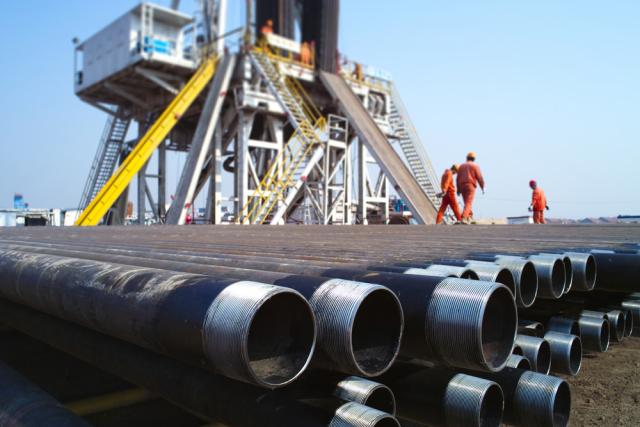
China could double its total natural gas production, reaching 325 Bcm in 2040, despite obstacles with shale gas and coalbed methane production, analyst says. (Source: Shutterstock.com)
Challenges faced in producing shale gas have prompted analysts to revise down forecasted gas production levels for China, meaning it could still be dependent on imports despite expectations to more than double gas production by 2040.
“While we are positive on conventional and tight gas output, the long-term growth of CBM [coalbed methane] and shale production looks to be challenging,” Xueke Wang, a consultant for Wood Mackenzie, said in a statement.
At fault for shale are inferior reservoir properties in the Ordos Basin and little shale gas exploration efforts in the Tarim Basin, the firm said this week, noting “desert environment and limited infrastructure add to the list of challenges” for the latter.
Plus, fears are that success seen at Sinopec’s Fuling Field in southwest China’s Chongqing municipality—where output surpassed 6 billion cubic meters (Bcm) in 2018—will be difficult to replicate elsewhere.
Wood Mackenzie lowered its long-term shale gas forecast for China by 44 Bcm to 88 Bcm in 2040. The downgrade contributed to the firm’s decision to lower its overall gas production forecast for China by 39 Bcm.
But tight gas and conventional production are picking up the slack, keeping the country on track to become the third biggest gas producer in the world within eight years.
China could still more than double its total natural gas production, reaching 325 Bcm in 2040—up from 149 Bcm in 2018, the firm forecast.
Conventional plays drove China’s 7% rise in domestic gas production last year, and an unconventional gas subsidy scheme that rewards “incremental growth based on subsidy-eligible volumes” could boost tight gas output.
“As such, more capital investment in tight gas is expected with potential commercialization of previously sub-economic and technically challenging tight gas reserves,” the firm said. “Accordingly, Wood Mackenzie increased its tight gas outlook to 85 Bcm by 2040.”
The revised outlook was delivered as China’s gas demand continues to grow and companies work to increase gas production amid rising imports and a push toward cleaner sources of energy.
Unfavorable project economics, regulatory and technical concerns and mediocre investment were cited as reasons for flat CBM production. The firm sees CBM production hitting 15 Bcm in 2040, down 40 Bcm from its previous outlook.
China’s regulators and shale players have not given up hope and continue working to overcome obstacles and improve field economics.
“To stimulate shale gas development, China has reduced resource tax on shale gas and urged NOCs to upgrade drilling plans,” Wang said. “Sinopec plans to spend RMB60 billion (41% increase year-on-year) on exploration capex in 2019, with a substantial portion budgeted for Fuling expansion.”
Operators grew shale gas production to 10 Bcm in 2018, from nearly nothing in 2010, to account for 7% of the country’s total gas production, according to Wood Mackenzie.
Plus, just like in shale plays in the U.S., China’s shale gas players are cutting well costs. Sinopec has shaved more than 40% off its comprehensive costs per well at Fuling since 2010, the firm said.
Meanwhile, efforts to increase gas production—conventional and unconventional—continue.
Earlier this year, Sinopec said it aimed to produce 1 Bcm by year-end from its Weirong shale gas field in Sichuan province, tapping part of the field’s 124.7 Bcm in proven reserves.
“In natural gas development, we constantly pushed forward capacity building in Hangjinqi of Neimongol, west Sichuan Depression and Weirong gas fields,” Sinopec said in its first-quarter 2019 report. “We accelerated construction of natural gas production, supply, storage and marketing system and promoted a coordinated growth along the value chain.”
The company’s gas production rose by nearly 7% to about 256 Bcf that quarter.
In August, Sinopec also said it added about 92.1 Bcm of proven natural gas reserves in the southwestern province of Sichuan. Reuters reported new reserves were discovered in the Yuanba, Zhongjiang and the Dayi gas fields.
Just this week, PetroChina Co., another top oil- and gas-producing company in Asia, reported marketable natural gas output of about 1.8 trillion cubic feet from domestic operations during first-half 2019, up 10.7% compared to the same time period last year.
“The group will strengthen the efficient development of gas fields, expand the deployment and implementation of large wells and horizontal wells, focus on shale gas production and organization, and strive to increase production,” PetroChina said in its latest interim report, referring to second-half 2019 goals.
Reuters reported Aug. 29 that PetroChina started to drill its first shale oil well in the Sichuan province earlier this month.
Recommended Reading
Beyond Energy: EnergyNet Expands Marketplace For Land, Real Assets
2024-09-03 - A pioneer in facilitating online oil and gas A&D transactions, EnergyNet is expanding its reach into surface land, renewables and other asset classes.
Weatherford Announces Acquisition of Technology Company Datagration
2024-09-03 - The acquisition gives Weatherford International digital offerings for production and asset optimization and demonstrates its commitment to continuously driving innovation across its technology portfolio, the company said.
Voyager Midstream Buys Haynesville G&P Assets from Phillips 66
2024-09-03 - Voyager Midstream acquired about 550 miles of natural gas pipelines, 400 MMcf/d of gas processing capacity and 12,000 bbl/d of NGL production capacity.
DNO Buys Stakes in Five Norwegian Sea Fields from Vår Energi
2024-09-03 - DNO’s acquisition of stakes from Vår Energi includes interests in four producing fields—Norne, Skuld, Urd and Marulk— and the Verdande development.
Transocean Scores $232MM Contract for Deepwater Atlas
2024-09-11 - Transocean’s newest $232 million ultra-deepwater contract follows the company’s $123 million contract for six wells offshore India by Reliance Industries.
Comments
Add new comment
This conversation is moderated according to Hart Energy community rules. Please read the rules before joining the discussion. If you’re experiencing any technical problems, please contact our customer care team.






